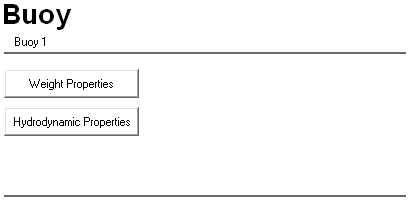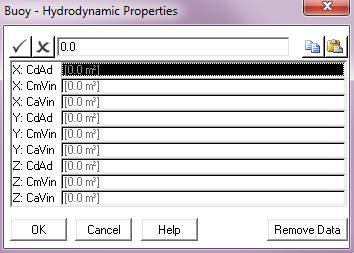The Buoy component is used to model point buoys, for use for example in modelling the installation of an in-line structure. They are added to the Model component by referencing them as start/end points for lines/cables.

Note
No hydrodynamic properties can be specified for Buoy components in PipeLay Starter Edition
A buoy is characterised by wet and dry weights, and these mandatory inputs are specified via the Weight Properties dialog. Specification of hydrodynamic properties is optional, but if required, appropriate values are input via the Hydrodynamic Properties dialog. The Buoy component is capable of modelling relatively complex subsea buoyancy structures, so the specification of hydrodynamic properties is comprehensive for complete generality. This is reflected in the Hydrodynamic Properties dialog, which is shown in the figure below.

Buoy Hydrodynamic Properties
The hydrodynamic properties of the buoy may be different in the vertical and horizontal directions. For this reason the hydrodynamic coefficients are specified separately for each of three directions (one vertical, two horizontal). Furthermore, for each direction the data is specified as three products, namely i) CdAd (drag coefficient by frontal area), for the hydrodynamic loading due to relative fluid/ structure velocity; ii) CmVin (inertia coefficient by reference volume), for the hydrodynamic loading due to structure acceleration; and iii) CaVin (added mass coefficient by reference volume), for the hydrodynamic loading due to water particle acceleration. This means the hydrodynamic properties of the buoy are characterised by nine hydrodynamic coefficients or products.
Additional articles describe the Buoy Data Inputs and Buoy Best Practice.